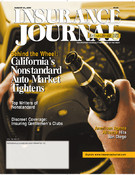Three out of every 10 Americans can expect to be involved in an alcohol-related vehicle crash at sometime during their lifetimes. Assuming that drunk driving is not strictly curtailed from current levels, that is the grim reality predicted by the Insurance Information Institute.
The good news is that, for the most part, incidents of drunk driving have been declining over the past several years, thanks to changing social attitudes and more stringent initiatives. For example, according to Anne DaVigo, public information officer for the California Highway Patrol (CHP), in 1998, the CHP made 89,079 drunk driving arrests, down from the 91,014 made in 1997. In 1990, nearly 159,000 arrests were made.
“The number of persons killed in 1999, according to our provisional figures, edges up just slightly over past years, but the persons injured continued to decline,” DaVigo said. “Considering the number of persons on the highway and the number of miles driven, which increased substantially over the year before, we still feel that Californians are continuing to be conscious of not drinking and driving.”
In addition to having adopted the .08 blood alcohol content (BAC) standard, California, like many other states, supported a variety of initiatives to combat drunk driving, including increased sobriety checkpoints and programs targeted at youths, such as the CHP’s Sober Grad program.
Terry Tyrpin, senior vice president of the National Association of Independent Insurers (NAII), said a major issue for the association in recent years has been legislation related to the concept of administrative license revocation (ALR).
ALR statutes, which as of July 2000 had been adopted by 41 states and the District of Columbia, allow for the suspension or revocation of an individual’s license when that individual’s BAC exceeds specified levels defining driving while intoxicated or upon refusal by that individual to submit to a BAC test.
“It is possibly the most important standard that does not exist on an all 50-state basis,” Tyrpin said. “Beyond that, yes, we’d like to see a .08 standard for BAC. There’s been a big [federal] movement trying to get all 50 states to go in that direction…We would like to…work at the state and local level to generate the kind of enthusiasm and support to change the law.”
The NAII is also a strong supporter of cutting edge trends which have been validated in state courts, such as confiscation/impoundment measures, in which an individual is deprived of his/her property rights in conjunction with demonstrated negligence and socially irresponsible driving. For repeat offenders, some of the laws that recognize impoundment rights go as far as confiscation and then forfeiture.
Also garnering recent attention are the so-called “No pay No play” laws, which prohibit drunk drivers from filing lawsuits for non-economic damages. These laws have been adopted in both California and New Jersey.
Overall, Tyrpin feels the nation seems to be “in a period of milder actions and leveraging the existing laws in the states that have the greatest populations.” In conclusion, he said that “there has been experimentation on the part of the states-in some cases, maybe some retrenchment-from some of the tighter laws when these laws have been challenged in court.”
Was this article valuable?
Here are more articles you may enjoy.


 State Farm Sued Over Policies Backed by Distressed Insurer PHL
State Farm Sued Over Policies Backed by Distressed Insurer PHL  Man Sentenced for Flashing Three Insurance Agencies in Georgia
Man Sentenced for Flashing Three Insurance Agencies in Georgia  Hartford: 10-Year Analysis Shows Shifts in Common, Expensive Small-Business Claims
Hartford: 10-Year Analysis Shows Shifts in Common, Expensive Small-Business Claims  Suit Against OpenAI and Microsoft Blames ChatGPT for Murder-Suicide
Suit Against OpenAI and Microsoft Blames ChatGPT for Murder-Suicide 


